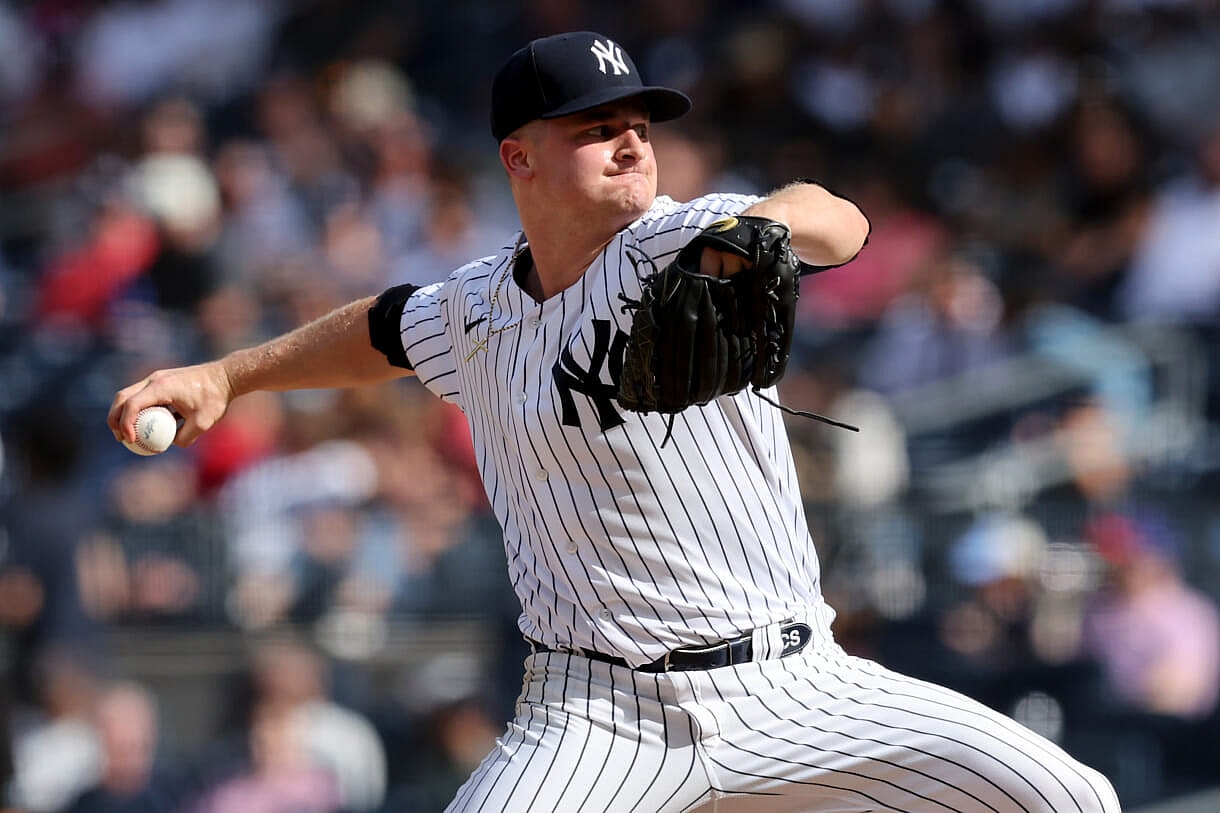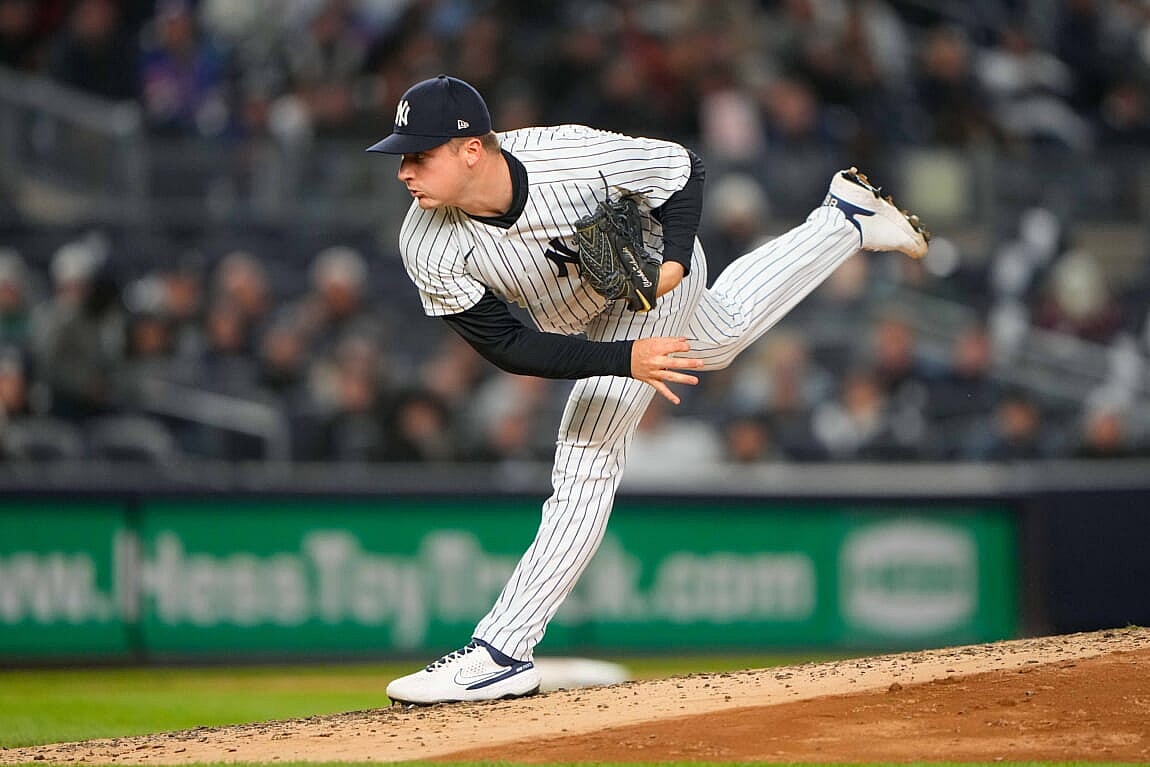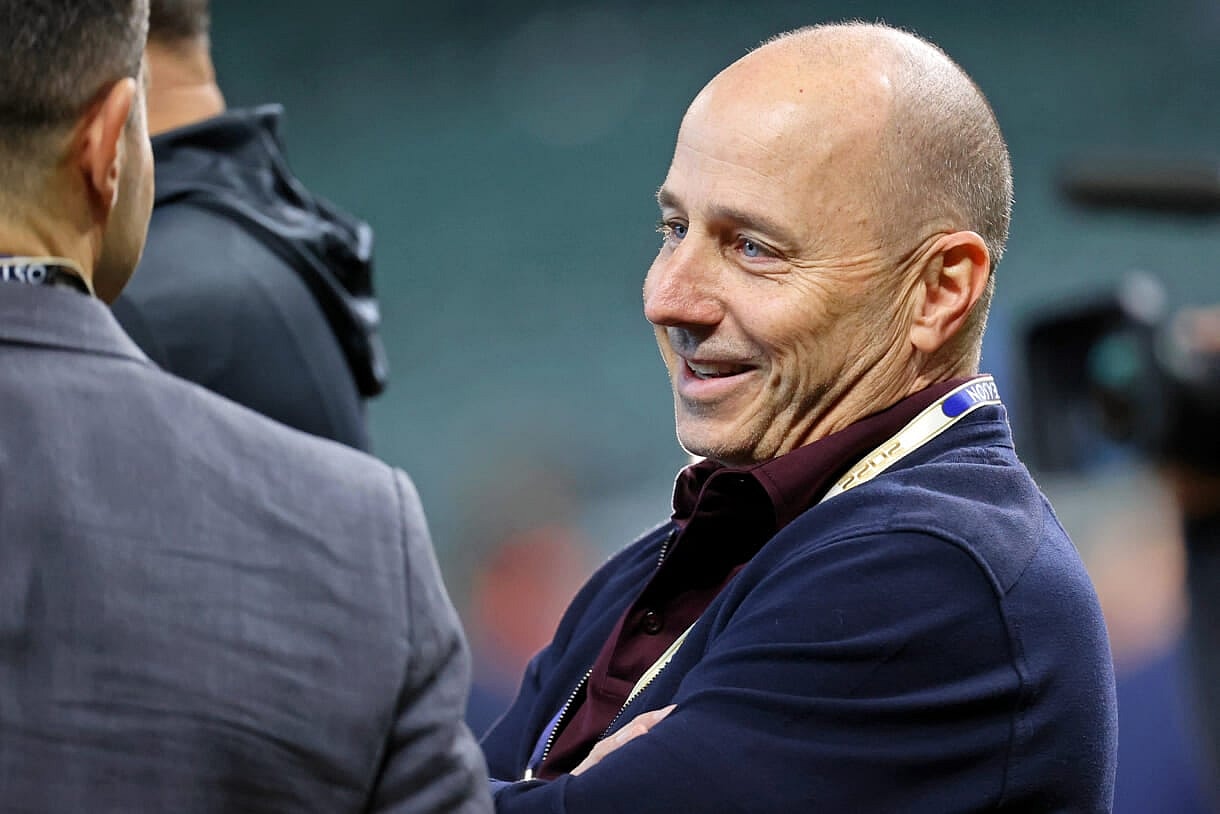
The Yankees received the unfortunate news that Frankie Montas will miss the first month of the season due to shoulder inflammation, meaning they’ll need a new 5th starter for April. While many people are wondering about the outlook of Montas for 2023, and rightfully so, there’s the question of who should be their 5th starter for now. Many people would default to Domingo German, whose 3.61 ERA as a spot-starter impressed many in the fanbase. The problem with this is that by all metrics, this is the wrong choice; Clarke Schmidt should become the 5th starter for the Yankees.
The University of South Carolina alumni was a former top-100 prospect, and his stuff is still top-of-the-line, leaving the Yankees with a prime opportunity to see what they have in the 27-year-old RHP.
- Cubs ‘working on a deal’ for Edward Cabrera; Yankees were ‘never close’ to getting him
- Yankees: MLB insider explains why Cody Bellinger holds ‘significant leverage’ in negotiations
- The Yankees might be disappointed by Gerrit Cole in 2026
Is He Better Than Domingo German?
Many people will immediately point to Domingo German as the more deserving starter. While I don’t disagree that he could be the favorite entering Spring Training, without a velocity spike or change in pitch profiles, there’s nothing that suggests he’s got better stuff than Clarke Schmidt. When trying to project future results, it’s important we look at key metrics that are usually sustained year-to-year that have a strong correlation to run prevention. We’re going to focus on three metrics that tend to have a strong correlation to run prevention and overall success, and those metrics are CSW%, K-BB%, and Stuff+. Before we get into evaluating German and Schmidt, let’s explain what these numbers mean.

CSW%: While it’s awfully similar to the abbreviation for ‘Chicago White Sox,’ it stands for Called Strikes Plus Whiffs, which is important for evaluating how often a pitcher is able to get strikes. It’s a simple number that has a strong correlation to K%, and getting strikeouts (as we discussed in this Gerrit Cole article) is one of the most important things a pitcher can do to have sustained success year-to-year. In 2022, the average CSW% was 27.5%, and a good rule of thumb is a pitcher having a CSW% of 30% or better is really good.
K-BB%: Probably the easiest metric to understand of the three, it’s simply taking your strikeout rate and subtracting your walk rate from it. In 2022, the league average K-BB% was 14.3%, and posting a K-BB% of over 20% is considered elite. Really good pitchers have elite K-BB% numbers, though this is a metric that a pitcher can underperform in if their CSW% and K% hasn’t translated entirely.
Stuff+: Stuff+ is the brainchild of Eno Sarris of The Athletic and Max Bay of the Houston Astros R&D team, and it’s a metric that can take your understanding of pitching to another level. This metric gives us a single number to evaluate how good a pitchers stuff is relative to the league average. 100 is average, being below 100 is below average and being above 100 is above average. It evaluates a pitch’s shape, velocity, movement, spin rates, release points, spin angles, and movement differences off of a fastball.
With these three metrics explained, let’s look at how Clarke Schmidt fared against Domingo German.
| Metric | Domingo German | Clarke Schmidt |
| CSW% | 28.5% | 30.2% |
| K-BB% | 13.1% | 14.0% |
| Stuff+ | 98.2 | 109.7 |
What we see is that Schmidt is clearly the more sustainably successful arm between the two, and he should be expected to perform better in 2023. It’s rare that a pitcher is worse in all three categories compared to another pitcher and then goes on to outperform them, so when looking at these trends, it’s easy to identify Schmidt as the clear-cut 5th starter. Clarke Schmidt’s K-BB% is the only metric he’s below average in, though his CSW% suggests he’s due to post a better K% in 2023. He used his slider more after getting called up again in July, and in that stretch, he had a 25.4% K% and 17.4% K-BB%, so perhaps we see positive regression there.

Projections would also suggest that Clarke Schmidt is going to outperform Domingo German in 2023, as we have three public projections that heavily favor Schmidt over German. Steamer, THE BAT, and Depth Charts all believe Schmidt will finish with an ERA under four while German will finish with an ERA above 4, though ZiPS favors German to Schmidt in run prevention. Having the better stuff, better strikeout potential, and better management of strikeout-to-walk rates allows me to confidently say that he’s better than Domingo German, but how good does that make Clarke Schmidt himself?
The Yankees Could See a Huge Leap in 2023
As I mentioned earlier, Clarke Schmidt shifted to a slider-first approach in the summer, and it was the right move for the 2017 1st Round Pick. His fastballs aren’t great, and quite frankly, there aren’t many starting pitchers who have fastballs good enough to throw >50% of the time. His slider was his 2nd best pitch in Stuff+ and Statcast’s Run Value, which evaluates the run impact of an event based on the runners on base, outs, ball, and strike count. It specifically dominated right-handed hitters to the tune of a .179 wOBA and 37.7% K%, with sweeping action at higher velocities than we typically see for sliders with lots of horizontal movement.
Batters chased more against Clarke Schmidt, leading to a 31.9% CSW% and 25.4% K%, notable increases that could translate to better strikeout numbers next season. Schmidt’s performance in that second MLB stint definitely showed plenty of positive signs as to what we can expect in 2023, and this is a huge part of what makes him such an electric arm. People forget that he was a highly-touted prospect who lost that status due to injuries and age, not due to a loss in actual skill or talent. There’s also a sign of positive regression for his BB% as well, with a 101.7 Location+ in 2022.
Location+ is also derived from Eno Sarris and Max Bay, and the spread for Location+ is a lot smaller, so every point really matters. His 9.7% BB% should see a drop in 2023 as it did in that second stint (8.0%), and if he’s able to have a K-BB% of ~17%, he should be a pretty good starting pitcher. He isn’t going to be asked to make 30 starts, most likely needed to make 5-6 starts before Montas returns, so there shouldn’t be the initial worries of fatigue setting in for Schmidt as a starter since they can mitigate that when he’s moved to the bullpen after Montas returns.
While his breaking stuff is nasty, there’s one glaring issue with Clarke Schmidt; his four-seam fastball.
Working Around The Dead Zone
When you think of a bad fastball, batters would describe it as a “flat” pitch, and this phenomenon typically occurs when a fastball sits in the “dead zone.” What’s the dead zone? It’s a range of vertical movement where a pitch doesn’t drop enough to be a good sinker or generate enough carry to play up in the zone like a good four-seam fastball. Not all pitchers are going to have good four-seam fastballs, but Clarke Schmidt not having a good four-seam fastball severely limits his ability to handle left-handed hitters.
Left-handed hitters tend to struggle with good vertical movement profiles against RHP, which is where a pitch like a curveball or changeup would be used. That being said, the effectiveness of those drop-heavy pitches rely on the four-seam fastball’s ability to generate vertical separation, so how can Schmidt work around a four-seamer that generates just 13.9″ of induced vertical break?
Clarke Schmidt can succeed as a solid 5th starter in his current form, but improving his changeup command would severely improve his vertical profile, as despite the poor IVBs on his four-seamer, he still somehow meets the 10″ of vertical separation threshold for good vertical separation from a FF-CH duo. At just an 83.3 Location+, there’s a reason batters were able to post a .386 wOBA against the pitch, as he consistently would miss his spots. By leaving his changeup hanging or throwing it well out of the zone, its 29.4% Whiff% is all but negated by an inability to put it in zone quadrants that it should typically succeed in.
If Clarke Schmidt has even decent command of the pitch, suddenly, he has a strong vertical profile for lefties, who had a .331 wOBA agaisnt Schmidt last season. His curveball is already a great pitch against left-handers, posting a .077 wOBA and 43.8% K%, and it’s a pitch that will continue to be a buzzsaw due to how ridiculous its shape is (136.6 Stuff+). It’s hard to ask a pitcher to simply “command a 5th pitch better”, but perhaps there’s an alternative to this left-handed problem, which could be elevating his four-seam fastball more against LHBs and hoping it can generate called strikes and set up a curveball.
Whichever route Schmidt decides to take, his four-seam fastball needs to establish better vertical movement profiles, so he doesn’t just become a same-handed specialist. There are examples of pitchers who have above-average four-seamers that live in the dead zone, such as Sonny Gray and Pablo Lopez. All three share the characteristic of having four-seamers that don’t have much run and don’t generate much carry, but Lopez and Gray both had above-average four-seamers, according to Run-Value. This is because Lopez has an elite changeup and Gray an elite curveball that generates vertical separation, giving a blueprint for Schmidt to follow.

The name of the game is deception, and Schmidt does have the movement to deceive left-handed batters, it’s about improving his ability to consistently execute. I hate to write this entire segment off as “Matt Blake can fix this,” but ultimately, he’s why I have faith in Schmidt. Player development is something the Yankees have improved dramatically post-pandemic, and that’s where I place my faith in the organization. I’m definitely not the first person to think Schmidt needs to improve how he handles left-handed bats, and I imagine that’ll be a massive point of emphasis for him next season.
Clarke Schmidt Could be a Cutter Candidate
Cutters are arguably the most underrated pitch in the sport, serving as soft-contact inducers that can generate low xBA batted balls, resulting in lower BABIPs for pitchers. Out of all pitches in the “fastball” category, the cutter induces the lowest wOBA and xwOBA of the group against left-handed batters from right-handed pitchers, also generating an 86.7 MPH Exit Velocity on average. While pitch shape plays a larger role than anything else, there is a trend that would suggest that cutters could be part of the solution for Clarke Schmidt. It’s a big ask of Schmidt to ask him to learn how to throw a 6th pitch, but it might be easier than we think.
Again, I’m not a pitching expert, nor can this be data tested in an article reliably since we can’t predict what his pitch shape would look like or his comfort throwing it. What we can do is look at his spin efficiencies and note that he’s always had poor active spin. Active Spin% on Baseball Savant tells us how much of a pitchers spin is going towards movement, and his four-seam fastball generates just a 68% Active Spin%, making it really inefficient. This would make him an ideal seam-shifted wake candidate, as cutters don’t typically rely on spin-induced movement in its flight path.
Seam-shifted wake is movement generated from how the seams of the baseball react with airflow, which is independent of spin-induced movement and causes pitches to move in ways the spin of the ball would suggest it shouldn’t move. This late break that batters struggle to pick up creates an effective pitch in the cutter as batters can be late on a pitch they could perceive as just one of Schmidt’s spin-inefficient four-seamers that instead sweeps across the plate either towards the batter if they’re left-handed or away from them if they’re right-handed. There’s legitimate evidence that Clarke Schmidt could be a cutter candidate, though that’s up to the Yankees to figure out.
Schmidt actually discussed how his four-seam fastball used to have more cut than ride in an interview back in 2021, though he never generated the ride he envisioned he could on his four-seamer, perhaps we see a return to that cutting action in a true cut-fastball. It’s a difficult thing to speculate on because of the uncertainty revolving his comfort levels with a cutter, but perhaps that’s a new angle he can take next season.
The Upside in Starting Clarke Schmidt
The most under-discussed angle of this conversation about the temporary 5th starter is the fact that there is a ton of upside in starting Clarke Schmidt. When talking about probable outcomes, we should be evaluating the best and worst-case scenarios as well. The Yankees could see Schmidt flounder in a starting role, in which case they’d simply slide him to the bullpen when Montas returns or slide him to the bullpen and start German. Nothing of value is truly lost in that regard, as assuming that German would have slid in and performed signficantly better would be assuming an outcome you cannot gurantee.
I could be entirely wrong, and Schmidt could be a worse pitcher than German, but the process as to how I reached my conclusion is strong enough to use for evaluating pitchers long-term (although perhaps factoring quality of contact would give me more precision). This is ultimately all that really matters in decision-making when evaluating an organization, as everyone is going to have misses. The Astros traded Josh Hader, the Dodgers traded Yordan Alvarez, and the Rays traded Jake Cronenworth; this kind of stuff happens to the very best, and it’ll happen to Cashman too.

The massive appeal here is the fact that Clarke Schmidt succeeding gives the Yankees two courses of action to take. Depending on how well he succeeds and the sustainability of said success, we could be looking at a long-term piece of the Yankees’ rotation. Remember, Nestor Cortes didn’t really figure things out as a starter full-time until 2022 at the age of 27, so there’s no reason to believe that 27-year-olds can’t have something just click for them. Let’s evaluate the two paths for the Yankees because, ultimately, this is too high of a ceiling to pass up on.
- Trade Clarke Schmidt at the deadline for a high-impact bat with control
- Make Clarke Schmidt a permanent starter in 2024
You’ve either secured a low-cost, long-term solution in your rotation and have four good starters anchored for the next three years, or you could flip Schmidt and get a really good hitter with control in return. Either way, the long-term outlook of the Yankees would dramatically improve, something you can’t really say about Domingo German. If German were to struggle, he doesn’t have MiLB options, nor does he possess the high-level stuff that would translate in the bullpen. His trade value would be all but gone, and he’d end up getting DFA’d.
If he succeeds and does really well, the Yankees will probably move him to the bullpen for Montas (as they would for Schmidt as well), but he doesn’t have that same trade-value ceiling. With just 1.5 years of control, he can’t get the same return from a rebuilding team who wouldn’t find much value in a 30-year-old SP who could leave in FA after 2023. As for the Yankees, he’d be another impending free agent after 2024, so relying on him to ever be a long-term rotation solution feels unrealistic.

We’ve discussed earlier that German doesn’t possess the potential Schmidt has, so it’s likely that his ceiling is a lot more limited than Clarke Schmidt’s. Ultimately, the Yankees don’t get the same long-term value from German hitting his ceiling as they would with Schmidt. They also most likely just aren’t getting better starts, and winning games in a difficult AL East is more important than ever. Yes, Domingo German had a 3.61 ERA and held it down as a spot starter, but said success was wildly unsustainable, with a FIP, xFIP, and SIERA well above 4. He’s a low-whiff pitcher who doesn’t even generate groundball contact, there’s just not much to like here.
The Yankees are trying to win the World Series, and that means playing your best players in the biggest roles. If the Yankees want to position themselves to not only win the AL East but also add to their pool of great trade chips, they should be starting Clarke Schmidt while Montas is out. He’s the best they have to fill in the role, and he’s got a shot to make himself a long-term piece of this Yankees’ squad.
More about: New York Yankees